Shell Starts Up 10-MW REFHYNE Hydrogen Electrolyzer, Eyes Expansion to 100 MW
The post Shell Starts Up 10-MW REFHYNE Hydrogen Electrolyzer, Eyes Expansion to 100 MW appeared first on POWER Magazine.
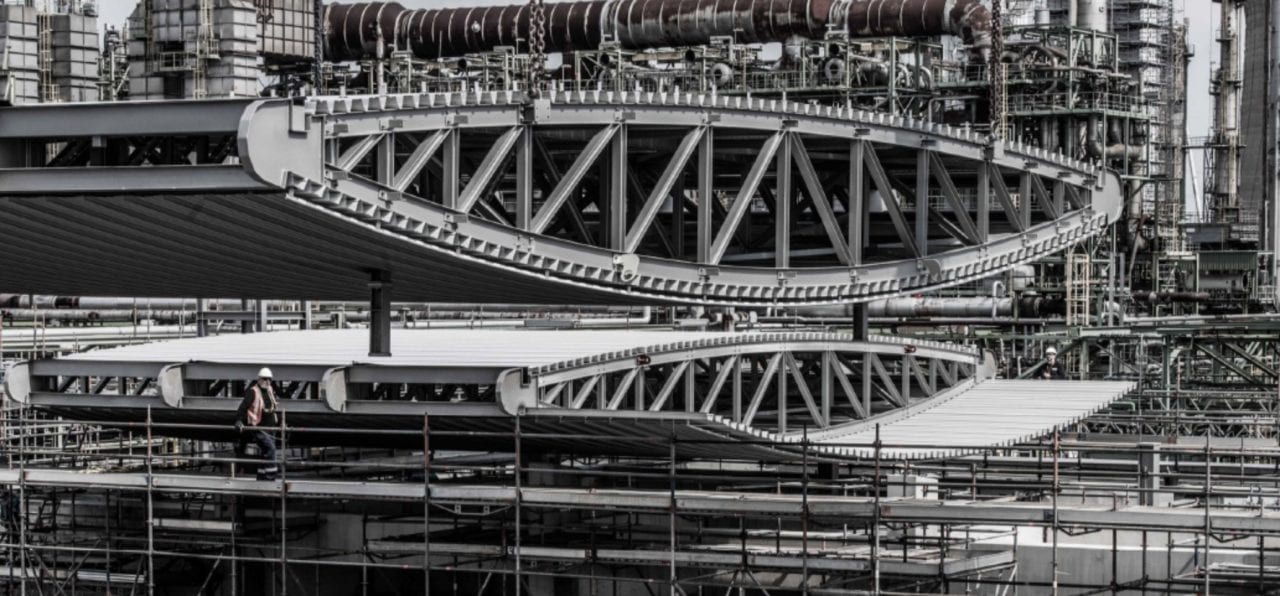
Shell Energy has started up a 10-MW polymer electrolyte membrane (PEM) electrolyzer facility-one of the largest of its kind in the world-to produce green hydrogen at its Energy and Chemicals Park Rheinland refinery in Wesseling, Germany, and it says plans are underway to expand the plant's capacity to 100 MW.
The startup of the electrolyzer plant on July 2 marks a major milestone for the REFHYNE project, a five-year undertaking that began in January 2018 with funding from the European Commission's Fuel Cells and Hydrogen Joint Undertaking (FCH-JU). According to Shell, electricity used in the 10-MW plant is being supplied by renewable energy sources, and the green hydrogen it produces-up to 1,300 tonnes per year-can be fully integrated into refining processes, for example, for the desulphurization of conventional fuels.
Along with Shell, the REFHYNE project's consortium included research organization SINTEF, consultant firms Sphera and Element Energy, and UK hydrogen technology firm ITM Power, which designed and manufactured the PEM electrolyzers.
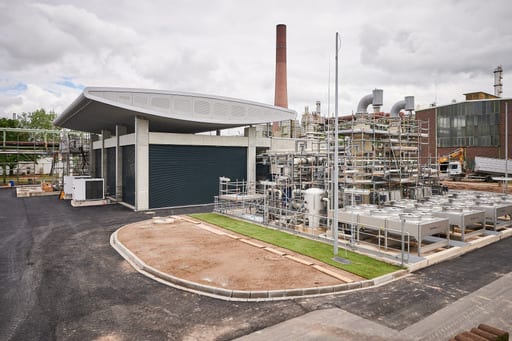 Europe's largest PEM hydrogen electrolyzer began operations on July 2 at Shell's Energy and Chemicals Park Rheinland, producing green hydrogen. Courtesy: Shell Energy
Europe's largest PEM hydrogen electrolyzer began operations on July 2 at Shell's Energy and Chemicals Park Rheinland, producing green hydrogen. Courtesy: Shell Energy
As Shell's Downstream Director, Huibert Vigeveno noted during the project's opening ceremony, the project demonstrates a new kind of energy future and a model of lower-carbon energy production that can be replicated worldwide." A key beneficiary is the state of North Rhine-Westphalia (NRW) in western Germany, a region that generates and consumes around 30% of Germany's power.
Positioning itself as a hydrogen economic powerhouse, NRW has set several targets under a recently issued hydrogen roadmap for 2025, including the buildout of 120 kilometers (km) of hydrogen pipelines that would be connected to the nation's first supra-regional" hydrogen lines. It is also targeting the buildout of electrolysis plants with a total capacity of 100 MW for industrial hydrogen production by 2025-and up to 3 GW by 2030. In June, the state notably backed a mass-production facility for anion exchange membrane (AEM) electrolyzers, a technology that could disrupt the conventional electrolyzer market, which is today dominated by alkaline and PEM technologies.
PEM Hydrogen-Producing Electrolyzer Projects Are Getting BiggerWhile PEM technology was commercialized in the 1960s by General Electric, its uptake as a green hydrogen solution has been less common when compared to alkaline electrolysis. According to the International Energy Agency's (IEA) hydrogen project database, in 2020 alkaline electrolyzers constituted about 65% of all operational low-carbon hydrogen production technologies, while PEM technologies comprised about 30%. The IEA estimated a total of 51 MW of PEM electrolyzers were operational worldwide out of a total 173 MW of low-carbon hydrogen production projects.
However, though it is a PEM electrolyzer project, Shell's REFHYNE project's capacity ranks the same as the 10-MW Fukushima Hydrogen Energy Research Field, an alkaline electrolyzer project put online in March 2020 by Japanese research entities New Energy and Industrial Technology Development Organization and companies Toshiba Energy Systems & Solutions, Tohoku Electric Power Co., and Iwatani Corp. The Japanese project ranked as one of the largest-class electrolyzers projects in the world-until this January, when Air Liquide began operating its 20-MW PEM electrolyzer in Becancour, Canada. Air Liquide's facility, which is equipped with Cummins (formerly Hydrogenics) PEM technology, produces 8.2 tonnes of hydrogen per day (or around 2,990 tonnes per year).
According to ITM Power, the heart of a PEM electrolysis system is the stack where the catalytic separation process takes place. The stack is an assembly of electrolysis cells and consists of a direct current source, and two electrodes (anode and cathode), which are coated with noble metals (platinum, ruthenium, or iridium) and are separated by an electrolyte (ion conductor)," it explains.
Passing an electric current, i.e., a stream of negatively charged electrons, through water starts the electrolysis process. The water, which contains positively charged hydrogen ions (H+ ) and negatively charged hydroxyl ions (OH-), reacts and hydrogen ions are neutralized and converted into molecules of hydrogen gas (H2) at the cathode. Meanwhile, at the anode, the applied current strips electrons from hydroxyl ions and converts them into molecules of oxygen gas (O2) and neutral water molecules." A PEM electrolyzer uses a thin (150-220-m-thick) proton-conducting polymer membrane which prevents the mixing of hydrogen and oxygen, but admits the transport of H+ ions, it notes.
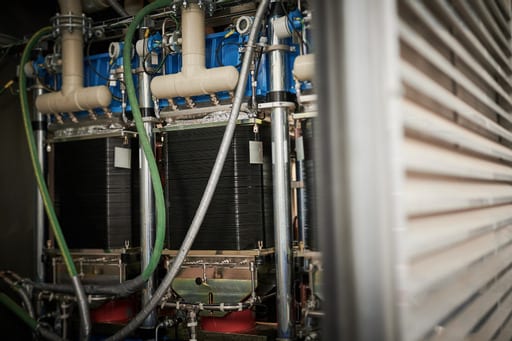 The Rheinland polymer electrolyte membrane (PEM) electrolyzer will use renewable electricity to produce up to 1,300 tonnes of green hydrogen a year. This will initially be used to produce fuels with lower carbon intensity," Shell said. The green hydrogen will also be used to help decarbonize other industries." Courtesy: Shell Energy
The Rheinland polymer electrolyte membrane (PEM) electrolyzer will use renewable electricity to produce up to 1,300 tonnes of green hydrogen a year. This will initially be used to produce fuels with lower carbon intensity," Shell said. The green hydrogen will also be used to help decarbonize other industries." Courtesy: Shell Energy
Experts have told POWER that PEMs generally avoid the recovery and recycling of the potassium hydroxide electrolyte solution that is necessary with alkaline electrolyzers. PEMs are also more efficient. The International Renewable Energy Agency (IRENA) last year projected conversion efficiencies of PEM technologies range from 65% to 83%.
ITM Power Bullish Cost Reductions for PEM TechnologiesITM Power notes PEM electrolyzers are gaining prominence in the competitive green hydrogen space today owing to their excellent" flexibility and reactivity characteristics. PEMs are able to operate at different input power levels [from zero to maximum power]," it says. The time required to respond to power constraints and reach sub-/supnominal current densities is very short. It can thus be ramped up and down in less than one second, and it is able to operate for a short time (typically 10 minutes) at a much higher capacity than nominal load (160%)," it adds. PEM electrolyzers are therefore capable of supplying frequency reserve and suitable for a wider range of grid services."
One drawback, however, is that PEMs need expensive electrode catalysts (platinum and iridium) and membrane materials, and their lifetime is currently shorter than that of alkaline electrolyzers. Still, ITM Power is optimistic about the downward cost trajectory projected for PEM technologies, suggesting in a November 2020 article that the price of an ITM Power 100-MW PEM electrolyzer system could fall to below 400 ($552)/ kW by 2024.
The economic attractiveness of water electrolysis, however, will critically depend on the power price, which accounts for up to 80% of hydrogen price, ITM Power says. A massive scaling up of hydrogen production, which will depend on the rising share of volatile wind and solar power, could also boost project economics.
ITM Power is readying for the soaring demand. This January, it completed a gigafactory" at Bessemer Park in Sheffield, UK, a facility that can crank out 1 GW of PEM electrolyzers per year. The facility, pivotally, delivers a blueprint for a high-capacity, semi-automated PEM electrolyzer manufacturing facility, which can be readily replicated," ITM Power said.
ITM, Linde Gearing Up for Bigger Hydrogen ProjectsITM Power, notably, has also bagged orders for a 20-MW PEM electrolyzer facility that will be sited at ScottishPower Renewables' Whitelee Wind Farm near Glasgow, the UK's largest onshore wind farm. That project is expected to supply hydrogen to the commercial market before 2023." Establishing a foothold in Japan's burgeoning hydrogen market, meanwhile, the company this March also sold an HGas2SP 1.4-MW electrolyzer to Japanese conglomerate Sumitomo Corp. Though the deployment will entail a modification to ensure hydrogen supply pressure is below 10 bar to comply with Japanese legal limits, it will serve as an important reference plant for further sales in Japan," it said.
However, ITM Power's biggest sale so far has been for a 24-MW PEM electrolyzer for Linde's Leuna Chemical Complex in Germany. That deal, announced in January, will be spearheaded by a newly created joint venture between ITM Power and Linde-ITM Linde Electrolysis. If the Leuna Chemical Complex is completed in the second half of 2022, it will likely become the largest PEM project in the world.
Linde plans to distribute liquefied green hydrogen produced by the project to refueling stations and other industrial customers in the region. The total green hydrogen being produced can fuel approximately six hundred fuel cell buses driving 40 million kilometers and saving up to 40,000 tons of carbon dioxide tailpipe emissions per year," it said.
But in parallel, Linde is also working on a variety of projects involving the production, processing, storage, and distribution of hydrogen. The Dublin-headquartered industrial gas and engineering company says it already has more than 80 electrolysis projects, and it is developing a pipeline networked of about 1,000 kilometers. However, it notes its hydrogen legacy stretches beyond a decade, owing to its 2020 merger with Praxair, a company that has operated the world's first high-purity hydrogen storage cavern" at Moss Bluff, Texas, since 2007.
REFHYNE 100-MW Expansion Could Power Pioneering Power-to-Liquids (PTL) EffortWhile Linde was not part of the consortium that built the 10-MW PEM REFHYNE project at Shell's Rhineland Refinery, the company is expected to partner with Shell and ITM Power to expand the REFHYNE project tenfold-to a 100-MW capacity. The expansion-dubbed REFHYNE II"-could begin construction next year if the consortium garners funding from the European Union and German government.
The expanded electrolyzer capacity is notably linked to Shell's efforts to manufacture sustainable" aviation fuels at the Rheinland refinery. Shell says it wants to set up a first" commercial bio-power-to-liquid (PTL) plant in a project that will entail the production of synthetic kerosene made from green hydrogen (using renewable and biomass power) and recycled carbon. A plant for liquefied renewable natural gas (bio-LNG) is also in development. Shell says construction of the PTL system could start in 2023, and it expects to start up at the end of 2025. The PTL plant could initially produce around 100,000 tons per year.
The Rheinland refinery is the engine and heart of Shell's activities in Germany and will play a key role in providing the products that are increasingly different from our current crude oil-dominated range and that will increasingly convert to regenerative solutions such as synthetic and biofuels as well as green hydrogen," explained Refinery Director Dr. Marco Richrath.
However, the 100-MW REFHYNE II and SAF projects are still at an advanced planning stage, with final investment decisions still pending," Shell noted. So far, the consortium for Refhyne II has been invited to prepare the associated grant agreement with the European Climate, Infrastructure, and Environment Executive Agency, it said.
Legally Compelled to Reduce Carbon Emissions, Shell Doubling Down on Hydrogen, CCS, RenewablesShell's Vigevano, meanwhile, pointed out that efforts at REFHYNE will be central to Shell's target to become a net-zero energy business by 2050. While the multinational company announced that goal last year, a Dutch court this May ordered the company to slash its absolute carbon emissions by 45% by 2030 by 2019 levels.
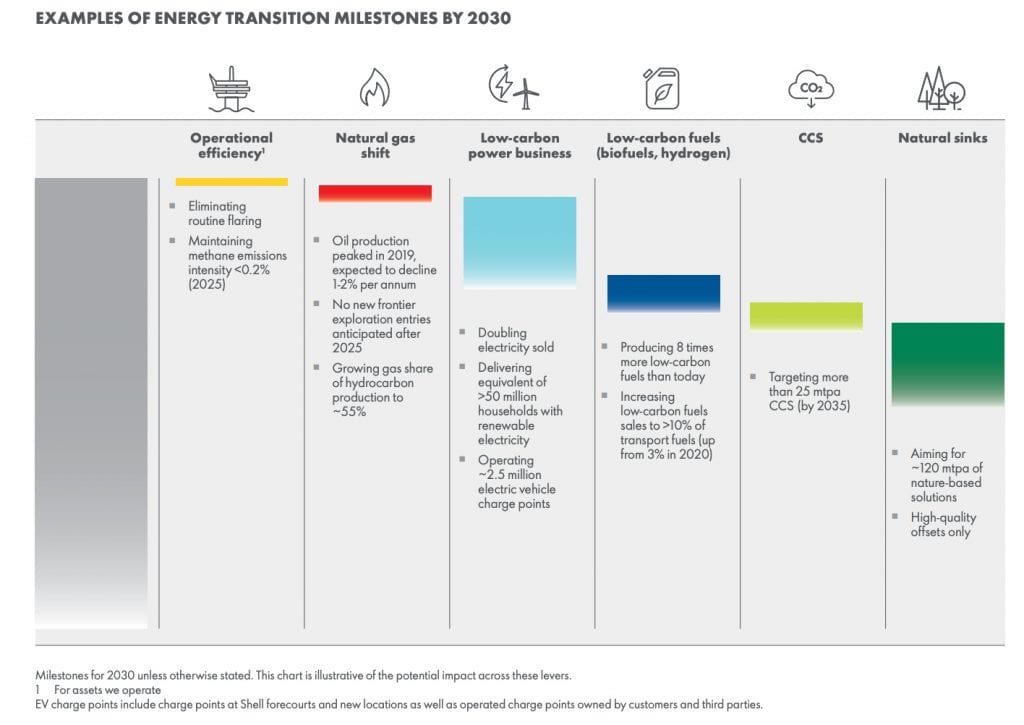 Shell expects the transformation of the energy system to net-zero emissions will require simultaneous action in three areas-an unprecedented improvement in the efficiency with which energy is used, a sharp reduction in the carbon intensity of the energy mix, and the mitigation of residual emissions using technology and natural sinks." It notes, however: While it is difficult to predict the exact combination of actions that will deliver the net-zero goal, scenarios help us to understand the direction and pace of the transition needed." Courtesy: Shell Energy
Shell expects the transformation of the energy system to net-zero emissions will require simultaneous action in three areas-an unprecedented improvement in the efficiency with which energy is used, a sharp reduction in the carbon intensity of the energy mix, and the mitigation of residual emissions using technology and natural sinks." It notes, however: While it is difficult to predict the exact combination of actions that will deliver the net-zero goal, scenarios help us to understand the direction and pace of the transition needed." Courtesy: Shell Energy
However, like many other oil majors, the company earlier this year had already set out one of the sector's most ambitious climate targets cut the carbon intensity of its products by at least 6% by 2023 (compared to 2016 levels), by 20% by 2030, by 45% by 2035, and by 100% by 2050 from 2016 levels. In its Energy Transition Strategy issued this May-a week before the landmark Hague district court ruling-the company outlined plans to ramp up carbon capture and storage, double its electricity sales to 560 TWh a year by 2030, and develop integrated hydrogen hubs.
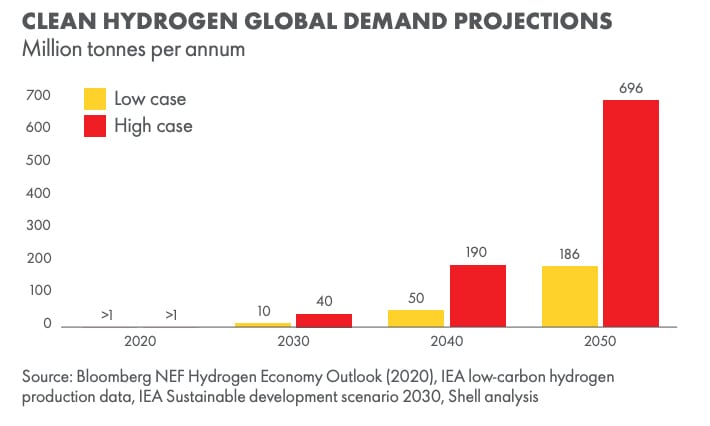 Shell is looking to cement a leading position in hydrogen by developing integrated hydrogen hubs initially to serve industry and heavy-duty transport. We will begin by producing and supplying hydrogen for our own manufacturing sites, especially refineries," it said. We will also continue to extend our network of hydrogen retail stations, with an increasing focus on heavy-duty transport." Courtesy: Shell Energy
Shell is looking to cement a leading position in hydrogen by developing integrated hydrogen hubs initially to serve industry and heavy-duty transport. We will begin by producing and supplying hydrogen for our own manufacturing sites, especially refineries," it said. We will also continue to extend our network of hydrogen retail stations, with an increasing focus on heavy-duty transport." Courtesy: Shell Energy
The clean hydrogen market is still in the early stages, and the volumes are still modest. But we see strong potential for growth, especially in hard-to-abate sectors of the economy. We aim to achieve a double-digit market share of global clean hydrogen sales by 2030," it said.
For now, Shell also plans to grow its power business with a focus on Europe, the U.S., Australia, and Asia. This year, it marked major deals in offshore wind, including for joint development of a 380-MW offshore wind project with Amazon off the coast of the Netherlands, and a majority stake in the 1-GW Emerald floating wind project offshore Ireland. Last week, as part of a consortium that includes France's EDF, Shell also won a bid to build the 1.5-GW Atlantic Shores wind farm.
Among Shell's notable onshore ventures is a 250-MW co-generation plant at its multibillion-dollar petrochemical complex in Pennsylvania that will use hydrogen as a fuel source. Shell is also building a new cogeneration plant at the Rheinland refinery that will use natural gas and 150 tons of steam per hour to generate power.
-Sonal Patel is a POWER senior associate editor (@sonalcpatel, @POWERmagazine)
The post Shell Starts Up 10-MW REFHYNE Hydrogen Electrolyzer, Eyes Expansion to 100 MW appeared first on POWER Magazine.